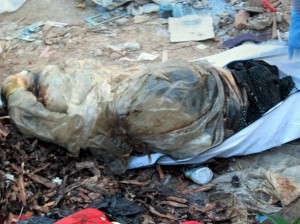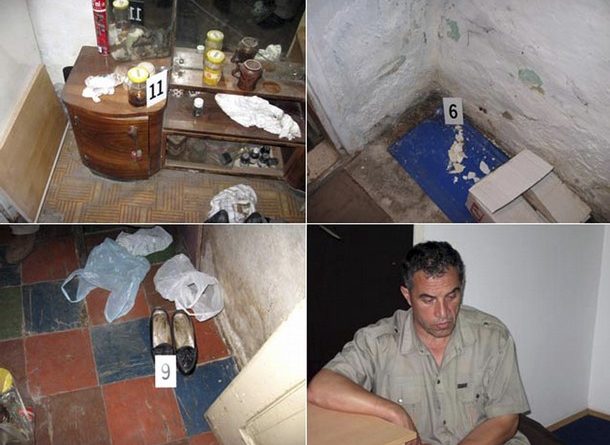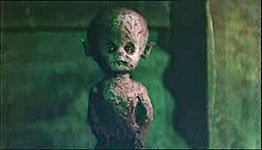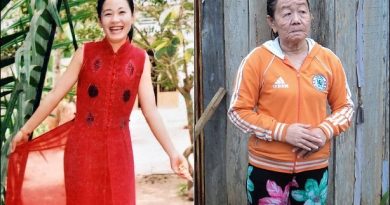Vlado Taneski: True Crime Writer Turned Psycho Serial Killer Murderer
Source :http://en.wikipedia.org/wiki/Vlado_Taneski
Vlado Taneski was a Macedonian crime reporter and serial killer. A career journalist for over 20 years, Taneski was arrested in June 2008 for the murder of two women on whose death he had also written articles. These articles on the murders had aroused the suspicion of the police, since they contained information which was not released to the public. After DNA tests connected Taneski to the murders, he was imprisoned on June 22, 2008 and was found dead in his cell the next day after an apparent suicide.
The Macedonian writer took investigative journalism to a whole new level when he covered a serial killers exploits in the town of Kicevo. In the mid-2000s, Taneski wrote about three women whod been violently raped and murdered. The women, ranging in age from 56 to 65, were all cleaners who resembled each other. Each one had been strangled with a telephone cord, stuffed into plastic bags and tossed outside town. Despite Taneskis quiet manner and meek personality, his columns kept readers enthralled with his incredible attention to all the grisly details.
In fact, his articles were so detailed they raised a few eyebrows among the local police force. Detectives wondered how Taneski knew things that had never been released to the public, like how the killer used the phone cord to tie up the corpses. Taneski even knew what kind of phone cord the killer was using. Investigators decided to get a sample of Taneskis DNAand found it matched the murderers semen. Taneski was arrested on suspicion of murder and all the pieces started falling into place. This respected journalist had a horrible relationship with his momwho just so happened to be a cleaner and looked like all three victims. But before Taneski could go to trial, he committed suicide in his cell, drowning himself in a bucket of water. Talk about an admission of guilt.
When Vlado Taneski wrote about the serial killer stalking his hometown in Macedonia, his eye for detail was such that the story was soon riveting readers. The journalist’s inside knowledge of the brutal murders of three elderly women in the tiny town of Kicevo ensured that newspaper editors gave his columns prominence.
Yesterday the 56-year-old father-of-two killed himself by dunking his head in a bucket of water in the toilet at a prison in the town of Tetovo, after it was revealed he had been charged with the murders he had written about.
“All these women were raped, molested and murdered in the most terrible way and we have very strong evidence that Taneski was responsible for all three,” said police spokesman Ivo Kotevski speaking from the capital Skopje. “In the end there were many things that pointed to him as a suspect and led us to file charges against him for two of the murders,” he added. “We were close to charging him with a third murder, and hoped he would give us details of a fourth woman who disappeared in 2003 – because we believe he was involved in that case, too.”
Of all the things which gave Taneski away, police point to his in-depth coverage of a story which is being reported as one of the most bizarre events to have befallen the two-million strong mini-state.
The three women were aged between 65 and 56. Zivana Temelkoska, Ljubica Licoska, and Mitra Simjanoska were each beaten repeatedly and strangled with a phone cable. Temelkoska was murdered in May, Licoska in February last year and Simjanoska in 2005.
Serial murders are rare in the two million strong eastern European nation of Macedonia. However, in 2008, a series of brutal rape-murders of older women were committed in the small Macedonian city of Kicevo. This seemed odd in view of the fact that a serial murderer had terrorized the Macedonian city of Ohrid in 2007.
Newspaper editors prominently placed articles about these crimes written by the respected Vlado Taneski. A journalist for over twenty years, this quiet, soft-spoken man, 56, enjoyed a sterling reputation. As Helena Smith observed in The Guardian, When Vlado Taneski wrote about the serial killer stalking his hometown in Macedonia, his eye for detail was such that the story was soon riveting readers. On May 19, 2008, the Nova Makedonija (in English: New Macedonia) published a piece by Vlado Taneski entitled Serial Killer Stalks Kicevo, Too. That article stated, in part, The people of Kicevo live in fear after another butchered body has been found in the town. The corpse strongly resembles one discovered 20 kilometres outside Kicevo last year and there is a possibility that these monstrous murders are the work of a serial killer. Both women were tortured and murdered in the same fashion, which rules out the possibility that this could have been done by two different people. Taneskis article states that it is unlikely these crimes are connected to the 2007 Ohrid murders since the Ohrid victims were all street-based money exchangers and the apparent motive of the murderer was to rob them.
After dismissing a possible link to the 2007 Ohrid murders, Taneskis piece continues, The motive of the Kicevo monster remains unclear. Both women were friends and living in the same part of town. Police have a few suspects who they are interrogating. The latest body was found in a rubbish dump. It had been tied up with a piece of phone cable with which the woman had clearly been previously strangled.
A body in a plastic bag found near Kicevo. Police handout photo.
Dan Bilefsky writes in The New York Times, In an article for another newspaper, [Taneski] faulted the police for implicating two men in the death of one of the victims, noting that they had been in jail at the time of the crimes.
Like everyone else, police officers read newspapers. When some police officers read Taneskis articles about the Ohrid murders, several eyebrows were raised. The article stated that the victims had been strangled with the phone cable that also bound them but the police department had not released that information to the public. In a part not quoted above, the article named the precise type of cable that had been used to strangle the victims and called it a signature weapon another fact not released to the public. No other journalist had reported these unreleased facts in any Macedonian newspaper and that made it even more suspicious that Taneski had. Police spokesperson Ivo Kotevski commented, We read his stories and it made us suspicious. He knew too much.
Police investigators wanted to know more about Taneski. They took a DNA sample from him. It matched the semen inside one of the Kicevo serial murder victims! In an article, Taneski had labeled the murderer a monster. Yet evidence clearly indicated that he was that monster!
On Sunday, June 21, 2008, a court ordered that Taneski be arrested and held without bail for thirty days pending the results of a police inquiry.Taneski was arrested at his home on June 22 and held in a jail located in the nearby town of Tetovo while police examined his house and property. He owned a cottage in a nearby village that police also thoroughly searched.
On June 23, 2008, he was found dead in his cell. He had apparently committed suicide by plunging his head into a bucket and drowning himself.
Many things about these horrible crimes and the self-described monster who perpetrated may never be known but what is known is both fascinating and chilling.

A body in a plastic bag found near Kicevo. Police handout photo.
Kotevski noted, All of these women were raped, molested and murdered in the most terrible way and we have strong evidence that Taneski was responsible for all three. In the end there were many things that pointed to him as a suspect and led us to file charges for two of the murders. We were close to charging him with a third murder and hoped he would give us details of a fourth woman who disappeared in 2003 because we believe he was involved in that case, too.
The body of cleaning woman Zivana Temelkoska, 65, was found in early 2008. The corpse of cleaner Ljubica Licoska, 56, was discovered in 2007. The body of Mitra Simjanoska, 64, also a cleaner by trade, was found in 2005. Each of them had been brutally and repeatedly beaten as well as raped and strangled. Police are still searching for a female cleaner, age 78, who has been missing since 2003.
The bodies of Temelkoska, Licoska, and Simjanoska had all been found nude, wrapped in telephone cables, and placed in nylon bags in various sections of Kicevo.
When Taneski was researching the articles on the case for newspapers, he visited and interviewed relatives of the slain women. Temelkoskas understandably dismayed and perplexed son, Zoran, told a reporter for a television network, He came to our home, we talked, and he asked for details. Who could imagine that it would be our neighbor in the end?
Taneski also interviewed victim Locoskas sister, Cvetanka, while researching his articles. She was shocked when she learned that the journalist writing about the case was also the culprit. I am very surprised by this outcome, she told another journalist. He came to me and asked for some details about my sister.
Why would Taneski, described by all who knew him as a polite and mild-mannered man, rape and murder these women? All of them bore striking similarities to his deceased mother. Like these victims, she had worked as a cleaner and had held that job for many years. All of the victims bore a physical resemblance to his mother. Whats more, each of them had known his mother. The relationship between Taneski and his mother had been extremely tense and became even more so after his father committed suicide in 1990. He may have blamed his mother for his fathers death and even believed that she drove him to take his own life.
An attractive man whose dark hair was just beginning to turn gray at the edges of his head, Taneski was married. His wife had given birth to two children during their marriage, both of them grown by the time of the murders. However, Taneski and his wife had separated prior to the slayings so it is possible that the friction between him and her aggravated Taneskis underlying mental problems.
As the facts in this horrible case came to light, many who knew Taneski expressed shock. Crime reporter Ognen Cancarevik had worked with Taneski at the New Macedonia newspaper. The two had even collaborated on articles about the Kicevo serial murders. When asked to describe his former colleague, Cancarevik answered, He was a nice and educated guy who seemed completely normal. When the police rang me to say, Your reporter is the murderer, I could barely believe my ears.
In retrospect, Cancarevik found it odd that Taneski had seemed unmoved when talking about the murders of victims who resided close to him. He was so calm when discussing the murders, Cancarevik recalled. All of these women lived only meters away from his house.
Goce Trpkovski, a reporter at the New Macedonia, remembered in an interview how Taneski called the office of that newspaper to tell them about his idea for an article on recent murders. On May 18, just after the gruesome murder of Zivana Temelkoska, he called and pitched the story to us, a clearly perplexed Trpkovski remembered. He was very quietly spoken but also very persuasive. As a contributor we published his story as the main article on the crime pages the next day under the headline A Serial Killer Stalks Kicevo, Too because the murders followed a series of killings in Ochid although they were nothing like this. To tell the truth, I didnt believe the story almost nothing happens in Macedonia, and suddenly we have two serial killers stalking our tiny country in a matter of months.
A busy and productive journalist, Taneski often wrote for a newspaper called Utrinski Vesnik. The baffled editor in chief of that newspaper, Ljupco Popovski, stated, I would never have believed that he was capable of doing something like that.
In an interview with a television station reporter, Taneskis estranged wife said she had enjoyed an ideal marriage with him for thirty-one years. She elaborated, He was always quiet and gentle. The only time I ever saw him get aggressive was when we were living with his parents. That last revelation supports the possibility that the victims were stand-ins for Taneskis mother.
Police are continuing their investigation. They are still hopeful that the 73-year-old cleaning woman who has been missing since 2003 will be located although they hold out little hope that she will be found alive. However, as Kotevski states, We may never know exactly what happened.
Yesterday the 56-year-old father-of-two killed himself by dunking his head in a bucket of water in the toilet at a prison in the town of Tetovo, after it was revealed he had been charged with the murders he had written about. “All these women were raped, molested and murdered in the most terrible way and we have very strong evidence that Taneski was responsible for all three,” said police spokesman Ivo Kotevski speaking from the capital Skopje. “In the end there were many things that pointed to him as a suspect and led us to file charges against him for two of the murders,” he added. “We were close to charging him with a third murder, and hoped he would give us details of a fourth woman who disappeared in 2003 – because we believe he was involved in that case, too.”
Of all the things which gave Taneski away, police point to his in-depth coverage of a story which is being reported as one of the most bizarre events to have befallen the two-million strong mini-state. The three women were aged between 65 and 56. Zivana Temelkoska, Ljubica Licoska, and Mitra Simjanoska were each beaten repeatedly and strangled with a phone cable. Temelkoska was murdered in May, Licoska in February last year and Simjanoska in 2005.
They shared a common background in being cleaners, a job which Taneski’s deceased mother had held for years. Each of the three bodies was discovered wrapped in plastic bags and dumped and discarded around Kicevo, a drab town southwest of Skopje with a population of fewer than 20,000. The fourth woman, aged 78, went missing in 2003, and her body has never been found.
It was the ostensibly mild-mannered journalist’s intricate account of the murders which led to suspicion.
But what made it unmistakable was his inclusion of details police had chosen not to release. Unlike any of his journalist rivals, Taneski knew the type of phone chord the killer used as his “signature weapon” – reporting, without attribution, that the cord had been used to strangle as well as tie up the bodies of the women; and, even more brazenly, he speculated about the chronology of the murders.
“On May 18, just after the gruesome murder of Zivana Temelkoska, he called and pitched the story to us,” said Goce Trpkovski, a reporter at the daily Nova Makedonija. “He was very quietly spoken but also very persuasive. As a contributor we published his story as the main article on the crime pages the next day – under the headline ‘A serial killer stalks Kicevo, too’ – because the murders followed a series of killings in Ochrid, although they were nothing like this. “To tell the truth, I didn’t believe the story – almost nothing happens in Macedonia, and suddenly we have two serial killers stalking our tiny country in a matter of months.”
What neither the staff at Utrinski Vesnik, another newspaper that he contributed to, or any of his many friends, could also believe, was how a man described as “unbelievably low-key and soft-natured” was capable of such crimes. Yesterday, his estranged wife told Canal 5, a local TV station, that she had enjoyed “an ideal marriage” with Taneski for 31 years. “He was always quiet and gentle. The only time I ever saw him get aggressive was when we were living with his parents,” she told the channel.
As police released more details yesterday, it did emerge there was also a darker side to Taneski’s life. A large collection of pornographic videos and magazines was found in his summer house. And, adding to the fact the victims were cleaners, as was Taneski’s dead mother, police noted all three bore a striking resemblance to her. He is believed to have had a troubled relationship with his mother, one which worsened considerably after his father killed himself in 1990.
“There is obvious symbolism in the fact that his mother, like the victims, was a cleaner,” said Antoni Novotni, a professor who heads the psychiatric clinic in Skopje. “This is pure speculation – as he was never my patient – but one explanation could be that he wanted to be caught by letting slip what he did in his articles,” Novotni told the Guardian.
“Perhaps he saw it as a way of resolving his inner problems, and getting rid of the burden which came with killing these women.”
Extract
From a piece by Vlado Taneski, published in Nova Makedonija on May 19 2008
The people of Kicevo live in fear after another butchered body has been found in the town. The corpse strongly resembles one discovered 20 kilometres outside Kicevo last year and there is a possibility that these monstrous murders are the work of a serial killer. Both women were tortured and murdered in the same fashion, which rules out the possibility that this could have been done by two different people. The Ochrid serial killer murdered three people [in 2007] but his victims were all street-based money exchangers and his motive was to rob them.
The motive of the Kicevo monster remains unclear. Both women were friends and living in the same part of town. Police have a few suspects who they are interrogating. The latest body was found in rubbish dump. It had been tied up with a piece of phone cable with which the woman had clearly been previously strangled.



